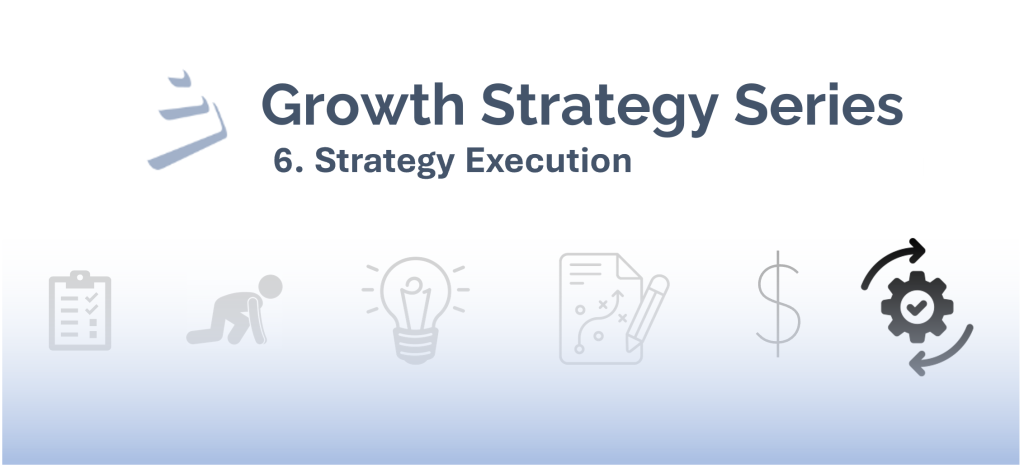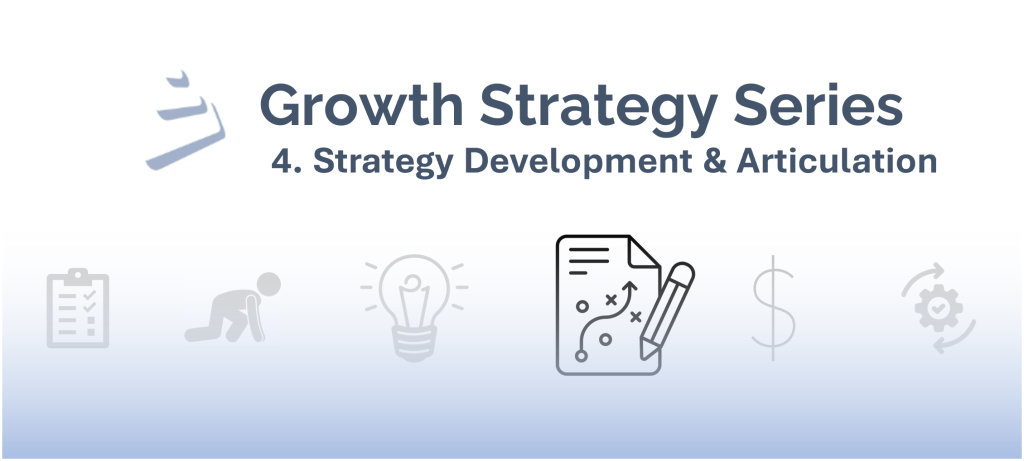As a consultant at Denneen & Company, a firm that focuses on growth strategy, not surprisingly, we have many conversations with clients on potential ways to grow. While our approach is to assess the entire enterprise, identify growth opportunities, and collaborate with clients to develop a clear, choiceful, and achievable paths to growth, we often find that many companies aren’t fully considering, and in some cases are neglecting, the range of potential growth choices. For those interested in growing topline sales, to help ensure that you’re exploring all avenues to growth, outlined below are eleven different growth choices to consider in your strategic plan going forward.
1. Product Innovation. Despite a high failure rate for new product introductions (up to 95% according to the late Harvard Business School professor Clayton Christensen), we see this all the time: new, improved, faster, stronger, waterproof, smaller, bigger, more absorbent, now with the fresh scent of lavender, etc. Product innovation is not often overlooked as an opportunity for growth. However, many companies innovate from the inside out, making changes and upgrades to products and services because they can, not because they should. Successful and meaningful product innovation is most commonly made from the outside in. They are rooted in understanding consumer and customer needs and innovating to meet those needs better than competition. ThyssenKrupp developed the world’s first rope-less elevator that can move both vertically and horizontally, which can not only increase transport capacity and reduce power demand, but also offer much greater flexibility in the architectural design of future buildings. What consumer or customer needs in your category are left unfilled, or even unarticulated?
2. Offer Innovation. Sometimes all it takes is a difference in how your product or service is delivered to increase sales. The Starbucks Rewards app, through which Starbucks consumers can order and pay for their preferred caffeinated beverages (along with everything else Starbucks offers), gain and redeem reward points, and load gift card credits, enhanced the overall Starbucks offer without making any changes to the product…coffee. Millions of consumers now use the app, which has been successful in driving greater loyalty and trade up into higher margin product offerings. How might you change your offer to better reach and engage with your target consumers?
3. Commercial Innovation. For decades, Snickers was viewed as a candy bar. In 2010, Snickers launched their “You’re not you when you’re hungry” campaign. This idea, what we would call a commercial innovation (a different way to talk about the same product), cleverly repositioned Snickers beyond candy bars into energy bars. Snickers effectively expanded the category in which they played and established new usage occasions for Snickers that previously would not have been considered for a candy bar. This new and innovative way to talk about their product drove incremental sales and was the start of what turned into a global campaign that lasted for years. Watch the original spot here: https://www.youtube.com/watch?v=OTPJYZLD6L8
4. Retail Innovation. Attempting to revolutionize the shelf for soup, a confusing and frustrating category to shop, Campbells introduced a “gravity-feed” shelving system in 2002, resulting in sales lifts up to 8%. Dr. Scholls places interactive, foot-mapping kiosks at retail to help consumers select the insoles that best fit their feet and stance. While the products remained the same, innovative shelving and merchandising at retail can also be a way to drive growth. And new technologies, like virtual and augmented reality, biometrics, AI-powered shopping assistants, and real-time product customization are enabling breakthough innovations at retail. And these innovations go beyond brick & mortar, as digital tools can identify indicative online habits and searches and specifically target messages and advertising to drive online sales. How can your brand be more easily found, shopped, and purchased?
5. New Business Models. Are you aware of how you might be disrupted? Are you considering new business models in your growth plan? Obviously, Blockbuster didn’t. While staying focused on the bricks and mortar video rental category, Blockbuster completely missed the transition to on-demand entertainment pioneered by Netflix. Netflix, to their credit, continues to expand their business model, which is now as much about creating and producing their own content than it is about an online entertainment subscription. E-commerce is a significant threat across numerous categories, as demonstrated by Dollar Shave Club, Blue Apron, Amazon Prime, and Google Express. Are you assessing and contemplating entirely new business models that could disrupt your industry?
6. New Geographies. Have you exhausted your ability to expand distribution into new and different markets? Despite strong incumbents in Apple and Samsung, Chinese telecom giant Huawei is busy driving distribution of their mobile phones in the US. While regulations, taxes/tariffs, and local customs often pose challenges for entering new geographies, assessing your global footprint can lead to opportunities in previously untapped markets. Where might you take your brand? And are you able to adapt it to markets with often different channels and consumer needs/preferences?
7. New Distribution Channels. What are the other ways that you can get your products or services to your target consumer and customers? Southern New Hampshire University has realized tremendous growth by expanding their educational offerings beyond the campus and offering a robust online college degree program. Not only is SNHU utilizing the new distribution platform, but through it they are able to reach a new segment of potential college students – ones who often don’t have the time or flexibility to attend a more traditional program, but who have the desire for a degree. Many companies now offer direct online sales while Amazon.com, Wal-Mart.com, and JD.com (among many others) offer turnkey online distribution. Often, companies are choosing to do both to maximize distribution via all available channels. Are you?
8. Brand Extension. Is there potential to expand a brand in your portfolio into a new or adjacent category? Virgin has both successfully, and unsuccessfully, expanded into numerous categories including music, trains, planes, coffee, games, healthcare, banking, comic books, and even space travel. Old Spice very successfully extended the brand from deodorant into the adjacent body wash category, significantly growing brand sales. Are there other product categories where your brand could fit? Just take care that you’re not launching the equivalent of the highly unsuccessful lineup of Dr. Pepper, A&W, and 7-Up marinades.
9. Partnerships & Co-Branding. Chinese Internet service provider Tencent and Warner Music Group recently announced a partnership that will see the distribution of the Warner Music Group’s catalog in China, while Warner Music Group will bring Gold Typhoon’s catalog of popular music from China, Hong Kong and Taiwan to the west. Tim Horton’s (coffee) sees most of its sales come in during the morning and afternoon while Cold Stone (ice cream) serves more customers in the evening. Creating a partnership and co-branded retail outlet, they’re able to effectively trade consumers across the two brands during less relevant times of the day. Who might you partner with?
10. Licensing. While licensing is already a core element of many blockbuster movies (e.g. Marvel, Harry Potter, and anything Disney) and across professional sports brands, Ford is estimated to generate over $2B in licensed product sales annually. Hershey’s has licensed products available in 25 countries and in over 600k retail locations across all channels including food, beverage, ice cream and desserts, along with a line of Kisses jewelry and Jolly Rancher lip balms. Do you have brands that may be worth licensing?
11. Inorganic. Years after P&G purchased Gillette for $57B, Unilever, wanting to get into the male shaving category, purchased Dollar Shave Club for $1B. Relatedly, Edgewell, owner of the Schick and Wilkinson razor brands, purchased Harry’s for $1.4B to complement an already strong shaving portfolio. A recent Forbes article pointed out that global M&A activity among the world’s top 50 consumer good companies reached a 15-year high in 2017, with deals totaling $145B. Understanding your industry’s M&A landscape and potential players that might strategically enhance your portfolio can lead to significant growth, including enhanced efficiencies and economies of scale too. What’s on your short list of acquisition targets? While there are likely many other more subtle and nuanced growth choices, the eleven options outlined above capture the essence of the areas that we most often assess for topline growth potential. Are you exploring all of your potential choices?
Growth strategy can be challenging and complex, and making bold strategic choices can be risky without a deep understanding of the internal and external environment. For over 25 years, Denneen & Company has helped hundreds of both B2C and B2B clients identify, articulate, and achieve their strategic growth goals. Our collaborative approach combined with robust analysis, insight generation, and extensive experience in leading brands and businesses helps to define a clear and practical path to growth, often via one or more of the topline growth choices outlined above. If you’d like to learn more, or just have a conversation about the challenges and opportunities facing your organization, we’d love to hear from you.


